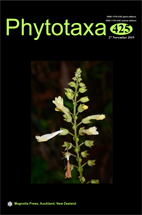Abstract
There are described and illustrated Eugenia andiraana, E. libens, Myrcia iranduba, M. javariana, M. piptocalyx and Plinia rufiflora, all from Amazonian Brazil; additionally, affinities and conservation issues are discussed for each species. Eugenia andiraana, from the state of Acre, is morphologically related to E. minuscula, differing by its pilose, longer blades; E. libens, from the state of Roraima, is related to E. callichroma, but has wider blades, persisting bracteoles and locules of the ovary with less ovules; M. iranduba is related, between others, to M. inaequiloba, but differs by its scarcely reticulated blades with acute or shortly acuminate apex and inflorescences with deciduous bracts; Myrcia javariana, from the state of Amazonas, is related to M. megapaniculata, but differs by its winged twigs, narrower blades and applanate inflorescences; M. piptocalyx, from Acre, is related to M. splendens but differs by its blades with larger glandular dots and deciduous calyx lobes, and Plinia rufiflora, from the state of Pará, is related to P. costata, but has blades with midvein and lateral veins raised on both sides and flowers with rufescent trichomes.

